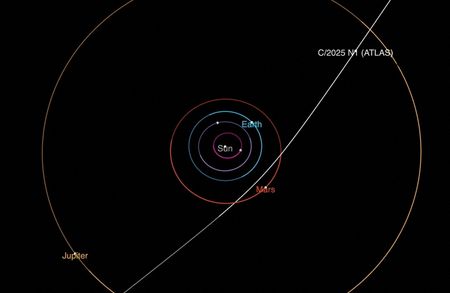By Will Dunham WASHINGTON (Reuters) -NASA is set on Wednesday to release new images of an interstellar object called 3I/ATLAS that astronomers have determined is a comet probably even older than our solar system. 3I/ATLAS was first spotted in July by an Asteroid Terrestrial-impact Last Alert System, or ATLAS, telescope located in Rio Hurtado, Chile, […]
Science
NASA set to release new images of interstellar object 3I/ATLAS

Audio By Carbonatix
By Will Dunham
WASHINGTON (Reuters) -NASA is set on Wednesday to release new images of an interstellar object called 3I/ATLAS that astronomers have determined is a comet probably even older than our solar system.
3I/ATLAS was first spotted in July by an Asteroid Terrestrial-impact Last Alert System, or ATLAS, telescope located in Rio Hurtado, Chile, and has been tracked by astronomers since then. Its unusual trajectory indicated that it was passing through our solar system from parts unknown.
NASA said 3I/ATLAS poses no threat to Earth and will get no closer than about 170 million miles (275 million km) to our planet. 3I/ATLAS flew within about 19 million miles (30 million km) of Mars last month.
NASA Associate Administrator Amit Kshatriya and Nicola Fox, associate administrator of NASA’s Science Mission Directorate, are among those due to discuss 3I/ATLAS on Wednesday at a briefing in Greenbelt, Maryland, to release the new imagery from telescopes and spacecraft, the U.S. space agency said.
Astronomers have intensively studied 3I/ATLAS since it was first detected.
“This is a comet that formed in another solar system, most likely more than eight billion years ago – which means it is older than our solar system, and the oldest thing we’ve ever seen close up,” University of Oxford astrophysicist Chris Lintott said.
Our solar system formed roughly 4.5 billion years ago.
3I/ATLAS is only the third interstellar object ever observed by astronomers traveling through the solar system. The others were objects called 1I/’Oumuamua (pronounced oh-MOO-uh-MOO-uh), detected in 2017, and 2I/Borisov, discovered in 2019.
“So far, it seems to be made of the same sort of stuff we see for comets in our solar system – plenty of carbon dioxide and some water, carbon monoxide and other such molecules. We’ve also seen cyanide – normal for a comet – and lots of nickel, which is a bit surprising but not too unprecedented. We saw similar things in a previous interstellar comet, 2I/Borisov, and in some solar system comets,” Lintott said.
3I/ATLAS is now on its way out of the solar system, according to University of Hawaii astronomer Larry Denneau, co-principal investigator for ATLAS. Its closest approach to the sun came in October, and its closest approach to the Earth will come in about a month, Denneau said.
The ATLAS network is a NASA-funded telescope survey built and operated by the University of Hawaii, with five telescopes around the world that scan the night sky continuously to look for objects that could threaten Earth.
3I/ATLAS has attracted attention because of one scientist’s suggestion that it is not a comet but rather alien technology due to its trajectory, composition and other factors. Most experts discount this view.
“Regarding the alien spacecraft hypothesis, it’s the usual ‘extraordinary claims require extraordinary evidence,'” Denneau said. “All evidence so far shows behavior by an object very similar to a solar system comet. Its motion is explained by the sun’s gravity. There is nothing that suggests otherwise.”
“It has not slowed down or changed its trajectory in any unusual way. It was behind the sun for a few months, and now that we can see it again it is exactly where it is supposed to be if it were a natural object,” Denneau said.
Lintott said, “The idea that 3I/ATLAS could be an alien spacecraft is simply nonsense. There’s nothing about it that suggests such a thing, and you might as well argue that the moon is made of cheese.”
(Reporting by Will Dunham)


